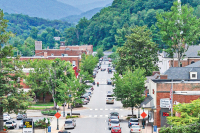Beauty of the cardinal flower
The fall wildflower season has arrived. Along roadsides and woodland edges some of our more robust native plants are now coming into full bloom. By “robust” I mean high growing and stout. These would include wild lettuce, common mullein, Joe Pye weed, green-headed coneflower, bull thistle, various species of woodland sunflowers, crown beard, boneset, white snakeroot, New York ironweed, cardinal flower, and others.
Cardinal flower stems can stand up to eight feet high but are more commonly between three and five feet. The stem and alternating leaves are rather coarse and certainly robust. Through the years, I’ve often written about cardinal flower, which favors wet ditches, damp pastures, marshes, and the banks of creeks and rivers throughout Western North Carolina. It’s one of my favorite wildflowers and is certainly one of the most beautiful plants in our flora.
Roger Tory Peterson once proclaimed it “America’s favorite,” and a survey conducted in the 1940s confirmed that appraisal. At that time, the New York Botanical garden surveyed 1,000 botanists and naturalists throughout North America, asking them to list the “most showy, conspicuous, and interesting wildflowers” in their regions. Showy lady’s slipper, which tallied 155 votes, came in second, followed, in the top 10, by New England aster (145), butterfly weed (141), moccasin flower (136), large-flowered white trillium (134), columbine (131), sweet-scented white water-lily (109), eastern fringed gentian (107), and marsh marigold (88). All were clearly outdistanced by the cardinal flower’s 213 votes.
Cardinal flower (Lobelia cardinalis), a member of the Bluebell Family, is one of the eight species of lobelia native to the Blue Ridge Province. All of the others — such as great lobelia, downy lobelia, and Indian tobacco — display flowers that are bluish in coloration. Cardinal flower’s common name is derived from the color of the vestments of officials in the Roman Catholic Church.
In 1626, the plant hunter John Tradescant sent plants back to his family’s botanical gardens in London. It rapidly became a favorite in the gardens of wealthy Europeans who, at that time, were specializing in developing so-called “American gardens.”
Its flowers are simply unsurpassed when it comes to displaying the color red. In a garden setting, they attract butterflies as well as hummingbirds. As might be suspected, the primary pollinator is the ruby-throated hummingbird. In fact, the ranges of the bird and the flower in eastern North America are almost identical, and they are highly dependent upon one another for survival. As the hummingbird feeds upon nectar at a male flower, pollen is distributed on its forehead from the anthers. At it moves along and feeds at a female flower, the pollen is then transferred to the female stigma and cross-fertilization is thereby accomplished.
Related Items
In recent decades, cardinal flower has become a popular garden plant in this country as well. Plants should not be collected in the wild, but seeds and plants are readily available from reputable nurseries. It isn’t picky when it comes to soil type and can be readily established in moist, partly sunny sites, especially in places that don’t freeze too hard in winter. Note that along streams, the plant’s basal leaves are naturally cleared of debris by periodic flooding — allowing the leaves to conduct year-round photosynthesis. The home gardener can accomplish the same ends by manually clearing the basal leaves during the fall and winter seasons.
George Ellison wrote the biographical introductions for the reissues of two Appalachian classics: Horace Kephart’s Our Southern Highlanders and James Mooney’s History, Myths, and Sacred Formulas of the Cherokees. In June 2005, a selection of his Back Then columns was published by The History Press in Charleston as Mountain Passages: Natural and Cultural History of Western North Carolina and the Great Smoky Mountains. Readers can contact him at P.O. Box 1262, Bryson City, N.C., 28713, or at This email address is being protected from spambots. You need JavaScript enabled to view it..









